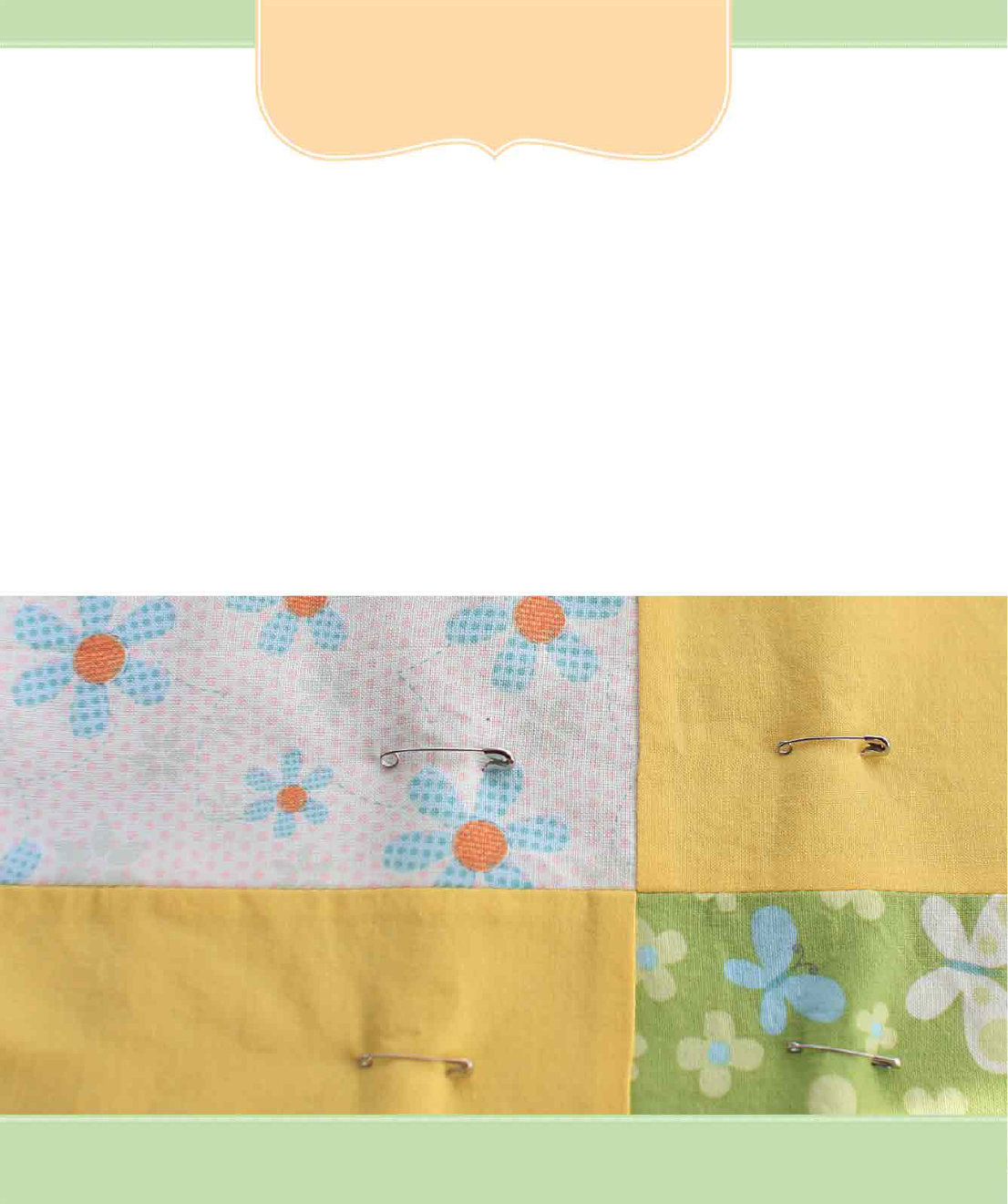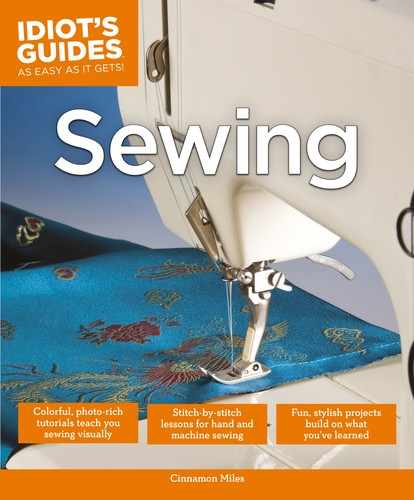
Quilting is a technique where you layer three fabrics to create a thicker, padded
material. It is often used to create quilts, but it can also be used to create pot
holders, placemats, or even pillow covers. It’s possible to quilt using your standard
sewing machine foot when working on small projects with no intersecting lines.
Asyou advance in this area and move on to bigger projects, however, you’ll likely
want to invest in a quilting foot, walking foot, or free-motion foot.
The different quilting methods are shown here—follow along and practice with
small scraps to perfect the technique. You’ll be making cute, quilted projects in
notime!
Types of Quilting
146 Part 3: More Techniques
nnCH10_Sewing.indd 146 5/23/13 3:39 PM

147Chapter 10: Decorative Techniques
Quilt batting
Backing fabric layer
Top fabric layer
Free-motion foot
1
⁄4-inch (.6 cm)
quilting foot
A rotary cutter, ruler, and self-
healing mat are used to cut strips
and blocks quickly.
Note: Most quilted projects are finished off with quilt
binding that wraps around the layered raw edges. You
can buy it prepackaged or make your own in a variety
of widths.
nnCH10_Sewing.indd 147 5/23/13 3:39 PM

148 Part 3: More Techniques
Layer the three fabrics, with the quilt batting
between the top and backing layers, right side
facing out. Starting at the center, mark your
stitching line on the top layer.
Following your marked line, straight stitch through
all three layers. Keep the fabric layers sandwiched
together and guide them through as one unit.
1
2
Measure and mark the remaining lines. Continue
to straight stitch along all of the evenly spaced
marked lines. Remove the pen marks with a light
mist of water.
Draw lines that intersect with your first set of
diagonal lines to create a diamond pattern, and
pin to prevent the fabric from puckering. Straight
stitch along all of the marked lines.
3
4
Channel and Diamond Quilting
Channel quilting has evenly spaced, straight lines. The lines can be horizontal, vertical, or diagonal.
Pin through all three layers to keep
the fabrics from shifting.
The pins are placed around the
machine foot; it’s best to leave them
in while sewing.
The lines shown here are stitched
on the diagonal and spaced 1 inch
(2.5 cm) apart.
nnCH10_Sewing.indd 148 5/23/13 3:39 PM

Stitch in the Ditch Quilting
Stitch in the ditch quilting draws attention to the pieced design because it follows the seam lines.
Sew a straight stitch right into the well of the
seam. Keep the fabric tight, and guide it through
without letting the layers shift.
2
3 4
The stitched line is sewn right into the seam to
emphasize the design and have each section
stand out. When done with a matching thread,
you’ll only notice the outlined shape.
A walking foot has a set of feed dogs on the bot-
tom of the foot. This is designed to work with the
feed dogs on the machine to pull both layers of
fabric together evenly.
Layer the pieced design at the top of your quilt
stack. Pin through all three layers, leaving space
for the machine foot to sew without having to
remove the pins.
1
149Chapter 10: Decorative Techniques
Safety pins are often used so that
a long-term project can be safely
folded for storage.
Walking foot
nnCH10_Sewing.indd 149 5/23/13 3:39 PM

150 Part 3: More Techniques
Stitch along the pattern of the fabric to create an
outline design. Pin and stitch, following the same
instructions mentioned in step 1 of Channel and
Diamond Quilting.
Stitch
1
⁄4 inch (.6 cm) away from the pieced seams,
pivoting at the corners. Use the
1
⁄4-inch quilting
foot as a guide to keep the seams consistent.
What Is a Quilt Block?
A quilt block is a small square piece of the top layer
of a quilt. It can be pieces of fabric sewn together or
an appliquéd design. You can find a variety of pat-
terns for quilt block designs.
Sewing the blocks together will make one quilt top.
The blocks for a quilt can be identical or made up of
different designs—it’s entirely up to you.
Sewing one block at a time makes it very easy to
work on a quilt project over a long period of time!
Method 2
Method 1
1
2
Outline Quilting
nnCH10_Sewing.indd 150 5/23/13 3:39 PM
..................Content has been hidden....................
You can't read the all page of ebook, please click here login for view all page.
